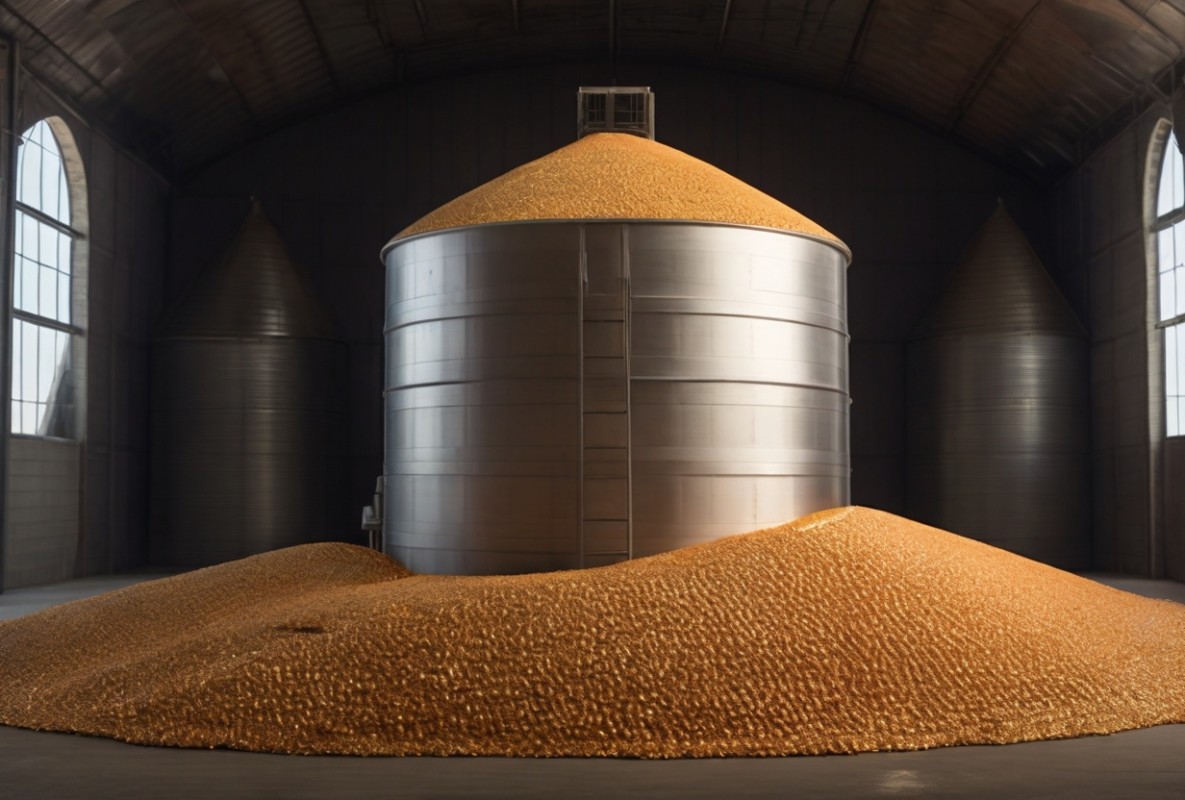Bitcoin and Grain: A Tale of Two Custodians


The collapse of FTX demonstrated the wisdom of separating market-making activities (Alameda) on the one hand from those of running the exchange (FTX) and custodian (FTX) on the other. However, whether to separate exchange operational activities from custodian activities is a more nuanced issue. Large banks often operate trading and custody businesses within the same entity, and use information barriers to control conflicts of interest and ensure that their assets are separate from those of their customers. This paper will draw on the experience of the American grain industry in the late 19th century to illustrate the importance of risk control between storage and execution activities.
Cryptocurrency storage
Custody of cryptoassets is a complex task that involves, among other things, protecting private keys and managing information security risks to keep transactions safe. The custodian also acts as a type of payment service provider, receiving and transferring cryptoassets according to the customer’s instructions.
Many of the early cryptocurrency exchanges bundled execution and custody for their large retail customer bases, and some continue to do so. When first launched, exchanges had to build capabilities to protect their own assets. Extending this feature to our retail customer base for free created much stronger customer relationships and was an indirect way to monetize the sunk costs of in-house storage contracts.
Since the failure of FTX, there have been efforts by both the private and public sectors to change this model. The private sector has seen widespread adoption of ‘exchange settlement’ (OES) by large exchanges, often in response to the needs of institutional clients. OES seeks to mitigate counterparty risk by eliminating the need for customers to store their cryptocurrencies on an exchange. Coincidentally, this is how Zodia Markets was designed from the beginning. In the public sphere, there have been regulatory actions, such as those from the SEC requiring investment advisers to use only qualified custodians for their clients’ crypto assets. There have also been consultations, such as with HM Treasury in the UK, which has indicated support for the separation of customer assets from those on the exchanges they use.
cryptocurrency exchange
Cryptocurrency exchanges and traditional exchanges have similar origins in that they mostly began as informal venues for retail customers. On the cryptocurrency side, Coinbase started as a private service for buying and selling Bitcoin via bank transfer, while Mt. Gox started as a trading service for card collectors. In the traditional world, the LSE started out as a private association of merchants based at John’s Coffee House in the City of London, while medieval Belgian merchants gathered in a pub called the Huis ter Beurze, giving rise to the term ‘booth’. ‘, as in Deutsche Börse. From a broader perspective, exchanges are designed to perform five functions:
- Standardization, such as through weights and measures or consistently designed trade agreements;
- Protection of property rights through rule books,
- Enforcing contracts through sanctions against malicious actors;
- Information asymmetries are often mitigated by disseminating information through transparent order books.
- Provide public goods by following the rules.
State judicial and legislative sanctions against these rules tended to follow, rather than the other way around.
Omnibus and Separate: Elevator and Sack
The development of grain exchanges in the United States in the second half of the 19th century, particularly the Chicago Board of Trade (CBOT), helps explain the tension between custodians on the one hand and exchanges on the other. As the United States expanded westward in the late 1840s and early 1850s, the amount of grain shipped to Chicago increased dramatically. Storage elevators, operated by warehouse workers, were large, specialized warehouses that stored grain in bins before shipping. In a sense, they are the equivalent of an omnibus crypto-asset custodian, with assets from various owners mixed in a single wallet.
CBOT began in the 1850s as a sleepy organization that was supposed to encourage attendance at its meetings by offering free meals. The exchange has grown to function as Function 1 in the list above: standardizing the grading, inspection and weighing of commodities, including grains. Warehouse employees operating the elevators came into conflict with grain merchants and transporters closer to the trading floor.
Storage of cryptoassets includes chain indexing and asset screening, among other things. Blockchain indexing facilitates the process of finding information stored on a blockchain instead of analyzing data block by block. This is done by storing the data in a central database where it can be parsed and queried. Indexing is a form of verification of the on-chain property rights of custodian customers. This is feature 2. Of course, you can do this yourself, but it’s much easier to pay a custodian to do it for you.
Because screening and scoring is specific to blockchain, it is a method of monitoring financial crime that has no real equivalent in traditional finance. Private companies provide scoring services to assess the financial crime exposure of specific assets or wallets. If your assets or wallet have recently interacted with addresses known to be associated with criminal activity, your score will be negatively impacted. This means that the notion that cryptocurrencies are completely fungible is not strictly speaking accurate. Each wallet and asset has a different score. If a custodian operates an omnibus wallet, this will mix assets of different scores, affecting the overall holding score.
The same is true for grains, in that they are not as fungible as one might imagine. There are different grades depending on the growing region, including Russian rye wheat, River Plate wheat, and East India wheat. Other grading criteria include moisture content, foreign matter, damaged grain, etc.
The challenge in the United States was the scale and sophistication of the storage infrastructure, where grain was collected in elevators before transport. This was different from countries like Argentina, where the infrastructure was less sophisticated and grain was transported in sacks.
Custodians running separate wallets for each customer are similar to sacks of grain in Argentina. Omnibus grain elevators created economies of scale through quantity and scale. However, this has the disadvantage of making quality more difficult to track compared to using bags of grain that can be tagged with a specific grade from the time of packaging until they reach the end customer. For cryptocurrency assets, omnibus wallets create economies of scale, including reducing on-chain transaction costs, but they also make scoring sets of individual assets more difficult, if not impossible.
Risks for Cominglings and Custodians Trading on Their Own Accounts
Mixing grain allowed warehousemen to engage in immoral activities. For example, you could receive a shipment of Grade 1 grain and then mix it with Grade 2 grain and still be within the acceptable range for Grade 1 grain. As a result, the warehouse was able to improve the quality of its own grain at the expense of others. This, of course, led to weight loss in those who stored high-quality grains in their elevators. This left farmers unable to ensure that their crops were of the highest quality. Further down the supply chain, shippers blend operations as close to the inter-grade threshold as possible, minimizing the loss of warehouse staff. In a sense, Gresham’s law is at work: poor quality grains crowd out good quality grains. In summary, standardization and property protection, functions 1 and 2 are flawed.
One of the key differences between cryptocurrencies and grain markets is that the grading and scoring of cryptocurrencies is performed by third-party private sector companies, as the data is public and anyone can do it. However, omnibus wallets limit this functionality because much of the transaction activity may occur off-chain and then be net settled into the omnibus wallet.
Another cause of tension centered on function 4. Warehouse operators, who can trade on the exchange but can also trade through the exchange in private transactions, have information about supply and demand as well as the quality of the grain being stored, creating a conflict of interest. This information was their property, and treating the information as property acts as an incentive for owners to produce and sell that information, but the counterargument is that mandatory disclosure can help prevent insider trading, market abuse, and adverse selection. there is.
Importantly, CBOT because warehousemen were tempted to engage in abusive and illegal practices where they were able to commingle their assets with those of their customers and trade for their own accounts. It is no surprise that the response to HMT’s consultation calling for the separation of company and customer assets has been overwhelming.
CBOT has long been in conflict with its warehouse staff as it struggles to enforce the same standardization of weights, dimensions and grades as it does for other assets, such as lumber. In 1906, the CBOT implemented a call rule that required all private trades entered into on the exchange to be at the close of the day. Warehousemen adhered to this rule because they feared being kicked out of the exchange more than the cost of following it. The rule also received judicial support for this important market function. This allowed CBOT to manage conflicts of interest, particularly among warehouse employees who could trade on their own accounts, but crucially, it could not manage them by prohibiting them from doing so.
All of this means that elevator economies of scale can be maintained while managing issues of conflict of interest and other tensions. What is readily apparent is that banning elevators or warehouse workers from trading is never a realistic option. Technology and the economies of scale it brought were seen as fundamental goods. That’s right. New risks arose, but over time, markets and regulators were able to manage these new risks according to models that have operated for over 100 years. I hope we can see the same attitude in the cryptocurrency market.
This is a guest post by Nick Philpott. The opinions expressed are solely personal and do not necessarily reflect the opinions of BTC Inc or Bitcoin Magazine.



